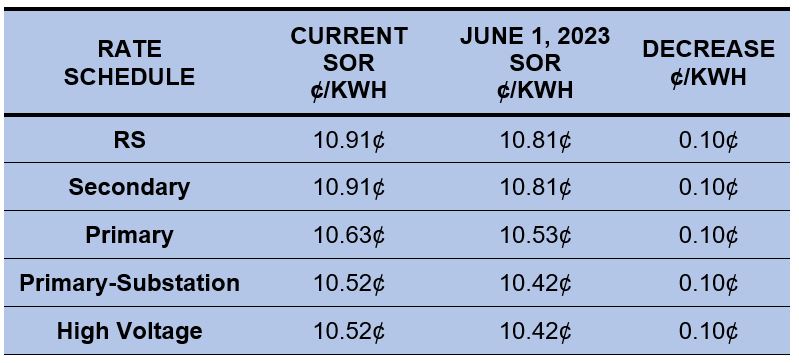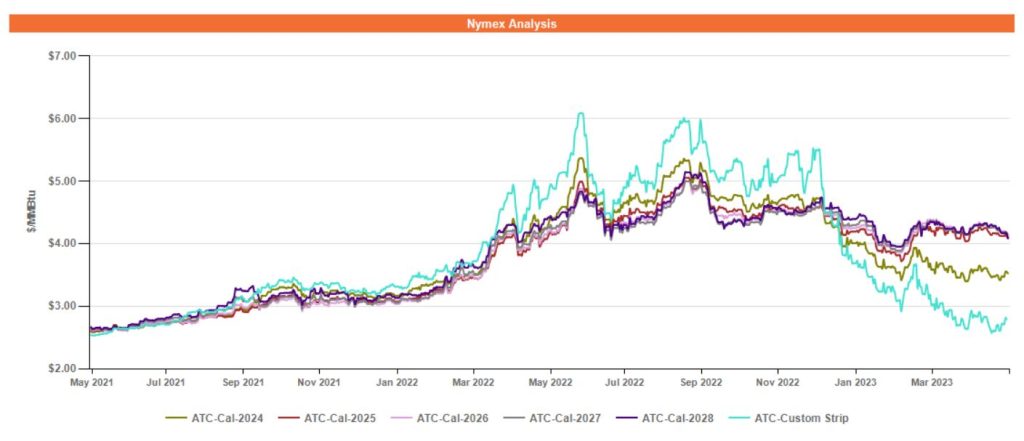Ohio Energy Report: May 2023
Take Steps This Summer to Mitigate Your 2024/2025 Capacity Costs
The start of this summer’s capacity cost management period is only two weeks away. For customers currently on a generation contract in which capacity charges are passed through, capacity charges are based on the customer’s metered demand during the five one-hour intervals of the year when demand on PJM’s electric grid is at its highest. These peak intervals, or Coincident Peaks (CPs), can occur during the months of June, July, August, and September. The customer’s average demand during Capacity CPs is used to determine its capacity charges for the next delivery year, which runs from June 1 through May 31.
In order to reduce the impact of capacity charges for the 2024/2025 delivery year, customers can implement measures to reduce demand during CPs that will be set this summer. To assist customers in their efforts to reduce demand during CPs, Brakey Energy provides an alert notification system. Customers that participate in the system can opt to reduce electric usage during alerted times.
Brakey Energy has issued a report to our clients that are enrolled to receive Capacity CP alerts this summer. The report discusses historic CP trends and provides our summer peak load forecasts. If you have not received this report, then we do not have you on our current enrollment list to receive summer CP alerts.
If you are not enrolled to receive these alerts and would like to participate, please email Catherine Nickoson. Please also contact Catherine to change your registration preferences, including adding or deleting which employees receive the alerts. This is a service available only to Brakey Energy clients.
Take Steps This Summer to Mitigate Your 2024 Transmission Costs
While capacity cost management is important, many customers can see the most pronounced savings through transmission cost management. Eligible FirstEnergy (FE) and AES Ohio customers can opt out of paying the utilities’ transmission-related riders and instead pay for transmission and other related services to their certified retail electric service suppliers. Participation in FE’s transmission pilot program is narrowly limited to the customers identified in FE’s most recent Electric Security Plan stipulation. This includes Brakey Energy clients. Participation in AES Ohio transmission pilot program is limited to the first 50 customers that served notice of eligibility to AES-Ohio before November 19, 2017.
American Electric Power (AEP) implemented a similar transmission pilot program as part of its modified third Electric Security Plan. However, unlike in FE and AES Ohio territory, the billing is not through a customer’s retail supplier and instead is handled directly by AEP. Participation in AEP’s pilot program is limited to a select group of customers.
For customers that enrolled their accounts in one of the transmission pilot programs (or those that intend to enroll for 2024), each customer’s transmission charges for the 2024 calendar year will be based on the customer’s demand during Transmission CPs set in 2023.
In order to reduce the impact of transmission charges, pilot program eligible customers can implement measures to reduce demand during Transmission CPs. To assist customers in their efforts to reduce demand during CPs, Brakey Energy has devised an alert notification system. Customers that participate in the system can opt to reduce electric usage during alerted times. This is a service available only to Brakey Energy clients.
If you are a participating client that would like to change your registration preferences, including adding or deleting which employees receive the alerts, please email Catherine Nickoson.
FE, AEP and AES Ohio Announce Updates to SSO/SOR Rates
Electric costs will be increasing significantly on June 1 for FE and AEP customers that take electric generation service under their respective electric distribution utility’s Standard Service Offer (SSO). The SSO is the default rate charged by the utility for generation services to customers that do not contract with an alternative supplier.
FE’s SSO generation rates are higher in the three summer months of June, July, and August than they are in the other nine months of the year. FE’s SSO rates will be more than doubling next month, while SSO costs for AEP’s customers will be increasing by approximately 60%. These rate increases are associated with each utility’s SSO auctions that took place in 2022 and 2023 for the 2023/2024 delivery year that begins June 1.
AES Ohio also recently filed updates to its Standard Offer Rate (SOR) that will go into effect on June 1. Unlike FE and AEP, AES Ohio’s current SOR has already been elevated. AES Ohio customers that take generation service from the utility will actually see a very slight decrease in SOR rates next month.
The tables below compare the current and June 1, 2023 SSO rates per kilowatt hour (kWh) for Ohio Edison (OE), Illuminating Company (CEI), and Toledo Edison (TE) Residential (RS), Secondary (GS), Primary (GP), Subtransmission (GSU), and Transmission (GT) rate schedules. These rates will change again slightly on July 1.
Table 1: FE SSO Rates

AEP recently filed updates to its Generation (GEN) Rider. These updates will go into effect on June 1, 2023 and electric bills rendered after June 1 will be subject to the new rate. The GEN Rider, which makes up approximately 92% of AEP’s overall SSO rate, reflects the results of AEP’s SSO auctions for the June 1, 2023 through May 31, 2024 delivery year. The clearing prices from these auctions were significantly higher than prices for the previous delivery year (i.e., June 1, 2022 through May 31, 2023).
The current and June 1, 2023 SSO per kWh rates for AEP’s RS and General Service Non-Demand Metered (GS-1), Secondary (GS-Secondary), Primary (GS-Primary), and Transmission (GS-Transmission) rate schedules are shown in the table below.
Table 2: AEP SSO Rates

The current and June 1, 2023 SOR per kWh for AES Ohio’s RS, Secondary, Primary, Primary-Substation, and High Voltage rate schedules are shown in the table below.
Table 3: AES Ohio SOR

If you would like more information about how FE, AEP, or AES Ohio’s recent rate updates will impact your monthly electric costs, please contact Katie Emling.
Transmission Costs Changing for AES Ohio Customers
Transmission costs for customers of AES Ohio will change on June 1, 2023 in response to AES Ohio’s updated Transmission Cost Recovery Rider – Nonbypassable (TCRR-N) rates. The TCRR-N has both kWh consumption and kW demand components. The energy component of the TCRR-N will be increasing by 58% for AES Ohio nonresidential customers. The demand component will be increasing for customers who receive service at Secondary voltage and decreasing slightly for Primary, Primary-Substation, and High Voltage customers.
The table below shows the current and proposed June 1, 2023 TCRR-N rates for customers of AES Ohio.
Table 4: Current and June 1, 2023 TCRR-N Rates for AES Ohio

Customers that are participating in AES Ohio’s transmission pilot program are opted out of paying the TCRR-N rider. If you have any questions about this pilot program or how the new TCRR-N rates will impact your electric costs, please contact Katie Emling.
Residential Corner
With SSO rates skyrocketing, it is urgent that residential customers competitively source power and not default to their electric distribution utility. We had been highlighting a very compelling 19-month offer from Direct Energy, which has since been pulled. Residents Energy is offering an attractive 8-month offer for 5.49¢ per kWh. As with most offers, just be sure to enter into a new agreement prior to expiration as to avoid being caught on an expensive holdover provision.
Regarding natural gas, to the extent you entered into a fixed-price residential natural gas contract that does not include an early termination fee, including the residential offers Brakey Energy highlighted prior to this past winter, you should seek to exit and either enter into a new agreement or default to the Standard Choice Offer (SCO).
Brakey Energy has long and often found defaulting to distribution utilities’ SCO a prudent strategy for natural gas supply. We encourage our readers to utilize this strategy if they are comfortable riding the highly volatile natural gas market – especially through the fall. To employ this strategy, you simply need to provide termination notice to your existing supplier and you will automatically be defaulted to the SCO.
Natural Gas Market Update
The NYMEX price for May settled at $2.117 per Million British Thermal Units (MMBtu) on April 26, 2023. This price is up 6.3% from April’s price of $1.991 per MMBtu. This settlement price is used to calculate May gas supply costs for customers that contract for a NYMEX-based index gas product.
The graph below shows the year-over-year monthly NYMEX settlement prices for 2019, 2020, 2021, 2022, and 2023 to-date. Prices shown are in dollars per MMBtu of natural gas.
Figure 1: NYMEX Monthly Natural Gas Settlement Prices

Figure 2 below shows the historical May 18, 2021 through May 18, 2023 Around the Clock (ATC) forward NYMEX natural gas prices in dollars per MMBtu for the balance of 2023 (labeled “Custom Strip” in the graph below) and calendar years 2024, 2025, 2026, 2027, and 2028. Natural gas prices for the balance of 2023 and calendar year 2024 continue to trade at lower levels compared to outlier years, reflecting a state of contango in the market after a long period of backwardation.
Figure 2: ATC Calendar Year NYMEX Natural Gas Prices

*Pricing courtesy of Direct Energy Business.
Electricity Market Update
Figure 3 below shows the historical May 18, 2021 through May 18, 2023 ATC forward power prices in dollars per Megawatt hour (MWh) for the balance of 2023 (labeled “Custom Strip” in the graph below) and calendar years 2024, 2025, 2026, 2027, and 2028 for the AD Hub. Like gas, the power market finds itself in a state of contango.
Figure 3: ATC Calendar Year Power Prices for the AD Hub

* Pricing courtesy of Direct Energy Business.